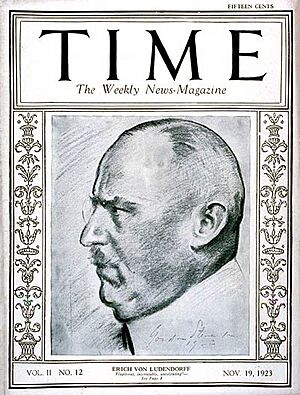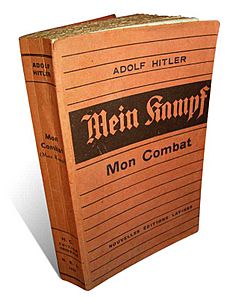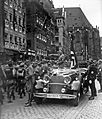Beer Hall Putsch facts for kids

The Beer Hall Putsch was a failed attempt by Adolf Hitler and his followers in the Nazi Party, including a famous World War I general named Erich Ludendorff, to take control of the government in Munich, Germany, in November 1923. It was a significant event in the early history of the Nazi Party, even though it didn't succeed at the time.
Contents
Background
To understand why the Beer Hall Putsch happened, we need to look at what Germany was like after World War I (which ended in 1918).
- Treaty of Versailles: Germany lost World War I and had to sign a treaty called the Treaty of Versailles. This treaty made Germany give up land, reduce its army, and pay a lot of money to the countries that won the war. Many Germans felt this treaty was very unfair and harsh.
- Economic Problems: Germany also had big economic problems, like hyperinflation, where money lost its value very quickly. Prices for everyday things became incredibly high.
- Political Unrest: The government in Germany at the time was called the Weimar Republic. It was a new democracy, and it faced many challenges. There were different political groups with very different ideas, and sometimes there was fighting and unrest.
- Beer Halls as Meeting Places: In cities like Munich, large beer halls were popular places where people gathered in the evenings. They weren't just for drinking; people would also talk about politics and social issues. Political groups sometimes held rallies in these large halls. One famous one was the Bürgerbräukeller.
- The Nazi Party: The Nazi Party was a relatively new political group led by Adolf Hitler. They were very unhappy with the situation in Germany, especially the Treaty of Versailles and the government. They believed Germany should be strong again and blamed various groups for the country's problems. Hitler was a powerful speaker and attracted many followers.
In 1923, the situation in Germany was very tense. The government in Bavaria had declared a state of emergency, giving special powers to certain leaders, including Gustav von Kahr. Hitler and the Nazi Party felt this was a good time to try and make a move.
The start of the putsch
The putsch was inspired by Benito Mussolini's successful March on Rome. Hitler and his planned to start in Munich and then march to Berlin, the capital of Germany, to take over the national government.
On the evening of November 8th, 1923, Gustav von Kahr was giving a speech to about 3,000 people in the Bürgerbräukeller beer hall. Hitler, along with a group of his followers from the Sturmabteilung (SA), which was like the Nazi Party's own army, surrounded the beer hall.
Hitler burst into the hall, fired a shot into the ceiling to get everyone's attention, and announced that a "national revolution" had begun. He declared that the Bavarian government was removed and announced a new government with himself and Erich Ludendorff.
Hitler took Kahr and two other leaders into a separate room and tried to force them to support his plan. He wanted them to join his new government.
Meanwhile, other groups of Nazi followers were sent to take control of important buildings in the city.
The March and the Confrontation
The next day, November 9th, 1923, Hitler, Ludendorff, and about 2,000 of their supporters marched through the streets of Munich. They didn't have a clear plan of where they were going, but Ludendorff suggested they march to the Bavarian Defence Ministry.
As they marched towards a square called the Odeonsplatz, they were met by a group of police officers who were blocking the way. The police were ordered to stop the marchers.
There was a confrontation, and shots were fired, which resulted in the deaths of 15 Nazis, four police officers, and one bystander.
The shooting stopped the march. The remaining Nazi supporters scattered, and many, including Hitler and Ludendorff, tried to escape.
Aftermath
Hitler managed to escape the scene but was arrested two days later. He and other leaders of the putsch were charged with treason, which is a very serious crime against the government.
Hitler's trial began in February 1924. He used the trial as an opportunity to speak about his political ideas and gain attention. The trial was widely reported in newspapers, which helped make Hitler known to people across Germany.
The judges were somewhat sympathetic to Hitler's political views. Although he was found guilty of treason, he received a relatively light sentence of five years in a special kind of prison called "fortress confinement." This type of prison was more comfortable than a regular jail, and prisoners were allowed visitors.
While in prison, Hitler dictated a book called "Mein Kampf" (which means "My Struggle"). This book outlined his political beliefs and plans for Germany.
Hitler didn't serve his full sentence. He was released from prison in December 1924, after only about nine months.
Legacy
Even though the Beer Hall Putsch failed to take power by force, it was an important event for the Nazi Party for several reasons:
- National Attention: The putsch and the trial brought Hitler and the Nazi Party to national attention. Before this, they were mainly known in Bavaria.
- Propaganda: The Nazi Party used the people who died in the putsch as "martyrs" for their cause. They created stories and symbols around this event to inspire their followers.
- Change in Strategy: The failure of the putsch taught Hitler that taking power by force was difficult. After his release from prison, he decided to focus on trying to gain power through legal means, like winning elections. This change in strategy was crucial to the Nazi Party's later success.
Over the years, especially after the Nazi Party came to power in 1933, the Beer Hall Putsch was celebrated every year as a key event in their history. Memorials were created, and ceremonies were held to remember the people who died.
Today, there is a plaque in Munich that remembers the four police officers who died trying to stop the putsch, honoring their sacrifice.
Images for kids
-
1 April 1924. Defendants in the Beer Hall Putsch trial. From left to right: Pernet, Weber, Frick, Kriebel, Ludendorff, Hitler, Bruckner, Röhm, and Wagner. Note that only two of the defendants (Hitler and Frick) were wearing civilian clothes. All those in uniform are carrying swords, indicating officer status
-
Adolf Hitler, Emil Maurice, Hermann Kriebel, Rudolf Hess, and Friedrich Weber at Landsberg Prison
See also
 In Spanish: Putsch de Múnich para niños
In Spanish: Putsch de Múnich para niños










